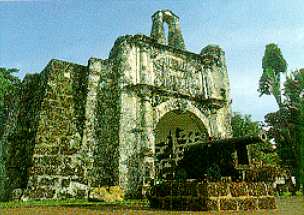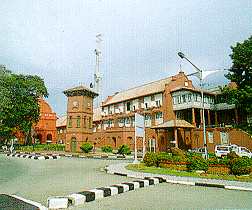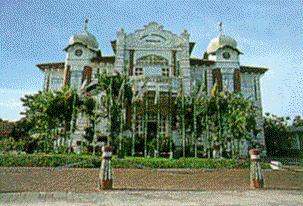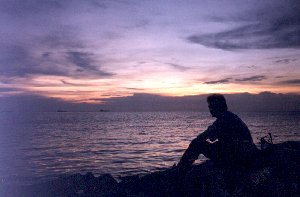Mmmmalacca...
I really enjoyed Malacca, Melaka, Mellaka, Malahk or whatever the
plate on the bus that takes you there says. It's just over 2 hours
away from Kuala Lumpur, and there's a large number of options for
where to stay. I was quite happy to stay at Malacca Town Holiday Lodge
I (yes, there is a sequel, II, just up the road), in a really nice and
clean room, shared bath, for 12 ringgit per night.
In Malacca there are just as many things to see as there are things
and places to eat. To cover all Western needs, there is Mahkota Parade,
a huge mall with everything from a bowling alley to Burger King and
high fashion clothes shops. I was there in late November, and had a
good time walking around and humming to the Christmas carols muzak.
 Malacca is at about 2 degrees North, so I had a tough day walking
around wearing jeans and a sweater (now I know where that name came
from) while I waited for my laundry to be done. It was an interesting
day, though, walking in the centre of old Malacca, seeing the remains
of Portuguese, Dutch and British colonization of the area. There's not
much left of the old fortress; All the walls are torn down, the only
part left is an entrance section, which was built by the Portuguese
and improved by the Dutch. On the top of the hill in the middle of the
town, the ruins of the St. Paul church can be found, with really old
tombstones. There was also a street musician playing the latest hits
on his guitar, probably making the people in the graves rotate pretty
heavily.
Malacca is at about 2 degrees North, so I had a tough day walking
around wearing jeans and a sweater (now I know where that name came
from) while I waited for my laundry to be done. It was an interesting
day, though, walking in the centre of old Malacca, seeing the remains
of Portuguese, Dutch and British colonization of the area. There's not
much left of the old fortress; All the walls are torn down, the only
part left is an entrance section, which was built by the Portuguese
and improved by the Dutch. On the top of the hill in the middle of the
town, the ruins of the St. Paul church can be found, with really old
tombstones. There was also a street musician playing the latest hits
on his guitar, probably making the people in the graves rotate pretty
heavily.
There is a museum in a historic building called Independence Hall,
which gives a very accurate, although possibly a bit too detailed (to
Westerners at least) impression of how Malaysia was formed by events
between 1945 and 1965. A much more interesting display can be found in
the old, Dutch Stadthuys (city hall), where the history of Malacca is
very well illustrated through a number of great paintings and some
rooms kept in the condition they used to be hundreds of years
ago. Malacca has been a very important place to control, because of
its strategic position for the trade between east and west by
boat. I loved this sentence describing the arrival of Europeans to
Malacca: "The arrival of the Portuguese was not the best thing that
happened to Melaka". You may want to skip having a look at the
literature museum in the lower floor, unless you have a VERY developed
interest in Malaysian writers.

A much more interesting kind of Malaysian writers can be found just
below the museum, opposite the post office. And they are even alive!
There's a row of serious-looking men with typewriters sitting there,
writing letters for people, either for money or for some goods. As
more and more people learn to read in Malaysia, this is a dying
profession, but it seemed very much alive when I was there. Nearby you
can find a hindu temple, a mosque and a Chinese family temple very
close to each other, as is typical of many Malaysian cities.
There's also a Pizza Hut place in the city, and they have ringgit 10.93
eat-as-much-as-you-can on Tuesdays after 6pm, which is a good way for
backpackers to fill up with fat food after lots of chicken and
rice. Having done so I went back to the lodge to do some reading and
talking to the others there. There was a TV in the main hall, and the
top story on November 26, 1996 was that the government of Malaysia had
decided to establish a Formula 1 racing team. Go figure. They spent
just about half the news program on giving us all the details on this.
The next day I could continue my museum-walking in shorts, and it was
much better than wearing warm clothes. A very interesting museum
taught me that ear ornaments originally was interpreted as a sign
that the person carrying the ear-ring or whatever had to listen, not
talk, and take orders from others. I suppose this makes sense in the
West, where most often it is the woman that carries jewelry in the
ears, although we have forgotten the reason for it being there. An
exception is of course the large golden rings worn in pirates ears,
which is worn in case of the pirate falling over board to be found
later by strangers. Then the gold could be used to finance a decent
funeral. A ring in the nose is a sign of being married, and seems to
be pretty universal. I also learned that the "longneck women" of
certain tribes in Thailand, Burma and Africa really are just
"low-shoulder-bone women". The neck itself is not prolonged by
building the long, thick necklaces. It was very interesting to learn
the background stories for the external enhancements people wear.
I also went to Bukit China, "China Hill", where the graves of many
generations of Chinese can be found. The graveyard is, as all Chinese
ones are, located on a hill overlooking the city, so that the
ancestors can keep track of what their families are up to. This
particular hill has more than 12,000 graves, and some are very
impressive ones. On the other side of the hill and a bit further away
from the city centre, the Portuguese part of the city can be
found. The buildings are mainly the same as elsewhere in the city, but
the people look like southern Europeans, except they have much darker
skin. I found this very fascinating, but I wasn't feeling adventurous
enough to try out one of the many Portuguese Seafood Restaurants that
could be found there.
 In the evenings during the summer, there is a Light & Sound
Spectacular (tm) show in the Independence Park. It's not really
spectacular, but definitely worth the 5 ringgit admission. As most
other attractions in Malacca, it is a presentation of the history of
the city. While it is technically impressive, it totally lacks any
entertaining or interesting anecdotes. "Melacca - The great envy of
all mighty nations"... Well, they certainly have self-confidence.
In the evenings during the summer, there is a Light & Sound
Spectacular (tm) show in the Independence Park. It's not really
spectacular, but definitely worth the 5 ringgit admission. As most
other attractions in Malacca, it is a presentation of the history of
the city. While it is technically impressive, it totally lacks any
entertaining or interesting anecdotes. "Melacca - The great envy of
all mighty nations"... Well, they certainly have self-confidence.
There are many possible daytrips to take from Malacca. One of them is
to take bus number 19 to Air Keroh and experience the rain forest. I
did, and I discovered why it is called rain forest. I sat under a
piece of plastic for more than an hour in heavy rain. And I liked
it. Nearby is a zoo and a crocodile farm, neither of particularly high
quality. People with the instinctive fear of reptiles might enjoy the
shows at the crocodile farm where a man stuffs a cobra down his
throat, some people wear pythons around their waists and of course the
men pulling crocodiles of various sizes by their tail.
The cheapest beach option is to take bus number 51 to Pantai Kundor,
which is a long and fairly beautiful beach. I suppose that it may
often be quite crowded, but I got off the bus at a hotel which seemed
to be occupied by Saudi-Arabians, who probably have got so much sand
at home that they certainly do not spend their time on the beach while on
vacation. To make it even more familiar to the Saudi-Arabians, there
was also an oil refinery just next door. Whatever the reason, I was
the only one at the beach that day, and it was nice enough for someone
who just wanted to read in the sun. Being this close to the Equator I
used sunblock factor 25, but I still got a small burn.
I spent my last ringgits on a ticket to Singapore and a trip to the
cinema. The movie theatre is a good place to spot cultural
differences, both in the people and in the movies. I chose to see
Dragonheart, which seemed like a movie I could like. So I got my
popcorn and my ticket and sat down. It was a bit like being in
Denmark, as practically all the pre-movie commercials were for Carlsberg
beer. And this was a childrens movie... Anyway, something went
completely wrong, because when Dragonheart started, all of a sudden it
was transformed into "101 Dalmatians", and I am pretty sure I did
everything right and went into the right theatre. They had kept the US
soundtrack, so I could follow the movie easily, but I was rather
distracted by the sporadic subtitling in both Chinese and Malay.
 So, that was the end of my visit to Malaysia. I'm not sure what to
say to sum up my feelings about the country. It is definitely a
civilized country, a lot more developed than Thailand and
Nepal. Their prime minister, Dr. Mahathir bin Mohamad, is among the most
powerful men in Asia, and he has presented a plan which shall lead
Malaysia to a status as a developed, industrialized country by the
year 2020. They seem to be on schedule, with a large economic growth,
at least before the recent Asian depression which has damaged the
South-East Asian economies so much that now is a really good time for
westerners to go visit. I'm confident Malaysia will strike back fairly
quick, and become a lot more Western soon, whether that is a good or
bad thing.
So, that was the end of my visit to Malaysia. I'm not sure what to
say to sum up my feelings about the country. It is definitely a
civilized country, a lot more developed than Thailand and
Nepal. Their prime minister, Dr. Mahathir bin Mohamad, is among the most
powerful men in Asia, and he has presented a plan which shall lead
Malaysia to a status as a developed, industrialized country by the
year 2020. They seem to be on schedule, with a large economic growth,
at least before the recent Asian depression which has damaged the
South-East Asian economies so much that now is a really good time for
westerners to go visit. I'm confident Malaysia will strike back fairly
quick, and become a lot more Western soon, whether that is a good or
bad thing.
 The language in Malaysia is easy to pick up, and their use of the
Latin alphabet certainly makes it easier to follow signposts than it
is in e.g. Thailand. The people are also very friendly, and there is
little unrest to be sensed between the Chinese and the other groups of
people. Malaysia has a lot of illegal immigrants, mainly people from
Bangladesh who work for very low salaries. I suppose these
people will be sent back if the economic depression lasts, but until
that happens, they are very much part of Malaysia and an important
factor in Malaysia's ability to offer cheap products.
The language in Malaysia is easy to pick up, and their use of the
Latin alphabet certainly makes it easier to follow signposts than it
is in e.g. Thailand. The people are also very friendly, and there is
little unrest to be sensed between the Chinese and the other groups of
people. Malaysia has a lot of illegal immigrants, mainly people from
Bangladesh who work for very low salaries. I suppose these
people will be sent back if the economic depression lasts, but until
that happens, they are very much part of Malaysia and an important
factor in Malaysia's ability to offer cheap products.
I certainly enjoyed my stay, but I also looked upon my trip to
Singapore with excitement.
Last modified: Sun Dec 16 13:11:20 CET 2001
 Malacca is at about 2 degrees North, so I had a tough day walking
around wearing jeans and a sweater (now I know where that name came
from) while I waited for my laundry to be done. It was an interesting
day, though, walking in the centre of old Malacca, seeing the remains
of Portuguese, Dutch and British colonization of the area. There's not
much left of the old fortress; All the walls are torn down, the only
part left is an entrance section, which was built by the Portuguese
and improved by the Dutch. On the top of the hill in the middle of the
town, the ruins of the St. Paul church can be found, with really old
tombstones. There was also a street musician playing the latest hits
on his guitar, probably making the people in the graves rotate pretty
heavily.
Malacca is at about 2 degrees North, so I had a tough day walking
around wearing jeans and a sweater (now I know where that name came
from) while I waited for my laundry to be done. It was an interesting
day, though, walking in the centre of old Malacca, seeing the remains
of Portuguese, Dutch and British colonization of the area. There's not
much left of the old fortress; All the walls are torn down, the only
part left is an entrance section, which was built by the Portuguese
and improved by the Dutch. On the top of the hill in the middle of the
town, the ruins of the St. Paul church can be found, with really old
tombstones. There was also a street musician playing the latest hits
on his guitar, probably making the people in the graves rotate pretty
heavily.

 In the evenings during the summer, there is a Light & Sound
Spectacular (tm) show in the Independence Park. It's not really
spectacular, but definitely worth the 5 ringgit admission. As most
other attractions in Malacca, it is a presentation of the history of
the city. While it is technically impressive, it totally lacks any
entertaining or interesting anecdotes. "Melacca - The great envy of
all mighty nations"... Well, they certainly have self-confidence.
In the evenings during the summer, there is a Light & Sound
Spectacular (tm) show in the Independence Park. It's not really
spectacular, but definitely worth the 5 ringgit admission. As most
other attractions in Malacca, it is a presentation of the history of
the city. While it is technically impressive, it totally lacks any
entertaining or interesting anecdotes. "Melacca - The great envy of
all mighty nations"... Well, they certainly have self-confidence.
 So, that was the end of my visit to Malaysia. I'm not sure what to
say to sum up my feelings about the country. It is definitely a
civilized country, a lot more developed than Thailand and
Nepal. Their prime minister, Dr. Mahathir bin Mohamad, is among the most
powerful men in Asia, and he has presented a plan which shall lead
Malaysia to a status as a developed, industrialized country by the
year 2020. They seem to be on schedule, with a large economic growth,
at least before the recent Asian depression which has damaged the
South-East Asian economies so much that now is a really good time for
westerners to go visit. I'm confident Malaysia will strike back fairly
quick, and become a lot more Western soon, whether that is a good or
bad thing.
So, that was the end of my visit to Malaysia. I'm not sure what to
say to sum up my feelings about the country. It is definitely a
civilized country, a lot more developed than Thailand and
Nepal. Their prime minister, Dr. Mahathir bin Mohamad, is among the most
powerful men in Asia, and he has presented a plan which shall lead
Malaysia to a status as a developed, industrialized country by the
year 2020. They seem to be on schedule, with a large economic growth,
at least before the recent Asian depression which has damaged the
South-East Asian economies so much that now is a really good time for
westerners to go visit. I'm confident Malaysia will strike back fairly
quick, and become a lot more Western soon, whether that is a good or
bad thing.
 The language in Malaysia is easy to pick up, and their use of the
Latin alphabet certainly makes it easier to follow signposts than it
is in e.g. Thailand. The people are also very friendly, and there is
little unrest to be sensed between the Chinese and the other groups of
people. Malaysia has a lot of illegal immigrants, mainly people from
Bangladesh who work for very low salaries. I suppose these
people will be sent back if the economic depression lasts, but until
that happens, they are very much part of Malaysia and an important
factor in Malaysia's ability to offer cheap products.
The language in Malaysia is easy to pick up, and their use of the
Latin alphabet certainly makes it easier to follow signposts than it
is in e.g. Thailand. The people are also very friendly, and there is
little unrest to be sensed between the Chinese and the other groups of
people. Malaysia has a lot of illegal immigrants, mainly people from
Bangladesh who work for very low salaries. I suppose these
people will be sent back if the economic depression lasts, but until
that happens, they are very much part of Malaysia and an important
factor in Malaysia's ability to offer cheap products.